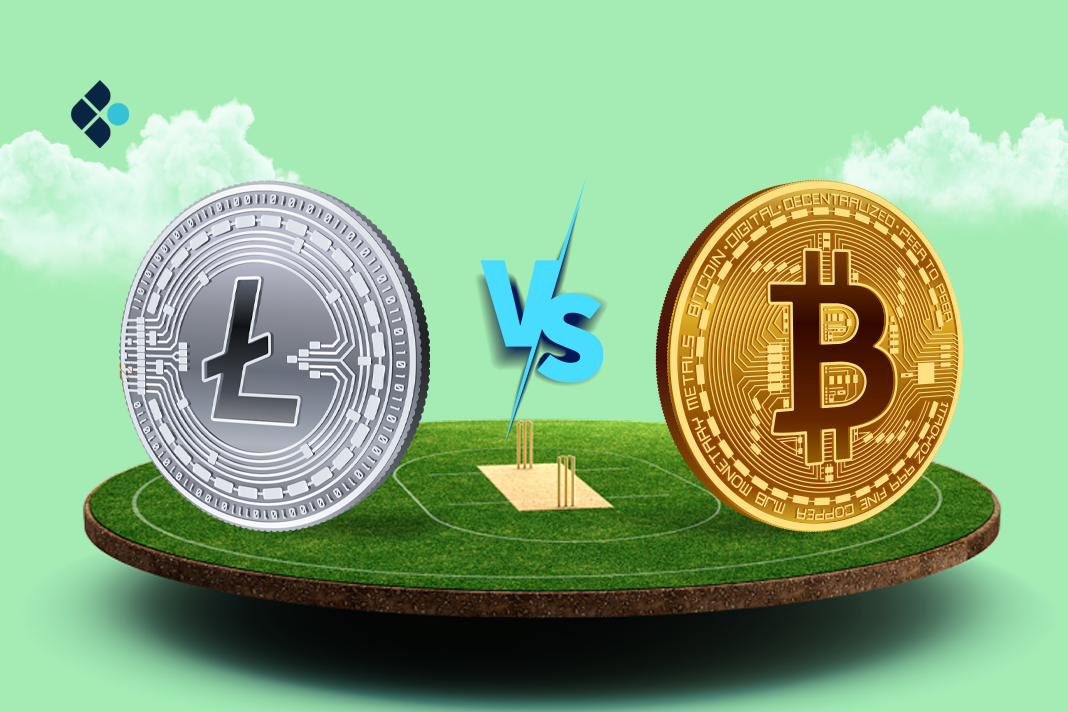Over the years, the interest in cryptocurrencies has increased, thanks to the convenience when it comes to transactions and their investing potential. While it was impossible for every cryptocurrency to stand out, Bitcoin and Litecoin stood the test of time, making them some of the most popular cryptocurrencies.
In this article, I have broken down the complex differences of Litecoin and Bitcoin into 5 points for you. So whether you are a newbie or an investor, it is spelt out in simple terms. Let’s take a brief look:
- Market capitalisation
- Transaction speed6
- Block rewards
- Algorithms
- Transaction fee.
We’ll get into these individually to show you the differences between Bitcoin and Litecoin so you can make an informed investment decision. Let’s delve into it.
5 differences Between Litecoin and Bitcoin
1. Market Capitalization
Litecoin and Bitcoin cryptocurrencies currently have different market capitalisations. Bitcoin is currently valued at a market cap of $670 billion, while Litecoin is valued at $4.95 billion.
Bitcoin and Litecoin have grown over time, with a market capitalisation of $1 billion and $70 million in 2013, respectively. Irrespective of the fact that the market can be pretty unstable sometimes, Bitcoin remains bigger than Litecoin by a landslide.
2. Transaction speed

Just like with any other transaction, they still need time for the other party to confirm the transactions. Depending on the traffic, Bitcoin’s average transaction confirmation time is less than 9 minutes. On the other hand, Litecoin’s transactions happen in less than 2.5 minutes. This is one of the reasons it was created and why it became known to crypto enthusiasts over time.
3. Block rewards
Block rewards are payments made to miners for completing new blocks of verified transactions. On Bitcoin, the reward for every transaction block is 6.25 BTC, while Litecoin’s reward stands at 6.25 LTC.
They both go through a “halving” process at recurring intervals, during which block rewards are slashed by 50 percent. The scheduled halvings of Litecoin and Bitcoin were planned for August 2023 and April or May 2024, respectively.
4. Algorithms
Regarding algorithms, Litecoin uses Scrypt, and Bitcoin uses SHA-256. They have different effects on how mining happens. SHA-256 is a more complex algorithm compared to Scrypt. To mine Bitcoins more effectively, the miners also experimented with some of the most advanced techniques.
Miners choose to use ASICs, which are hardware devices designed to mine Bitcoins, to achieve this. However, more people are looking at Litecoin since Scrypt was designed in a way that makes it less vulnerable to ASIC-based mining custom hardware solutions. For new miners, Litecoin appears to be more accessible.
5. Transaction fee

As of May 2023, Bitcoin’s transaction fee ranged from $3 to $6. On the other hand, Litecoin’s fee went from $0.03 to $0.04.
Frequently Asked Questions (FAQs) About 5 differences between Litecoin and Bitcoin.
Is Litecoin more stable than Bitcoin?
No, Litecoin is not more stable than Bitcoin. An edge that Bitcoin has is being the most popular with the best reputation, like no other crypto token. It has even been tagged “Digital gold” and has been a good asset since its introduction.
It is also more secure than Litecoin because of its high hash rate. This high hash rate means more computational power is required to attack. At the moment, the Bitcoin blockchain is highly resistant to any hacks, which makes it a lot more stable than Litecoin.
What will Litecoin and Bitcoin be in 5 years?
This question is quite a slippery slope. Any future prediction for both Litecoin and Bitcoin is difficult because of their volatility. Meanwhile, many believe that crypto, especially Litecoin, will be one of the most significant coins in the world.
However, this is still a budding industry. This means that if crypto adoption increases alongside other factors, like government regulations, then crypto’s growth can skyrocket over the next few years.
What are the flaws of Litecoin?
Even though Litecoin is a prominent cryptocurrency, it offers benefits such as faster transaction speeds and lower fees than Bitcoin. It still has some flaws. Some include technological risks, regulatory uncertainties, market volatility, and liquidity concerns.
Due to its inability to meet the security and Store of Value (SoV) characteristics of stable coins like Bitcoin, Litecoin’s use case in the cryptocurrency ecosystem remains susceptible to cyber attacks.
Are Litecoin and Bitcoin worth owning?
Generally, investments in cryptocurrencies carry a significant risk. However, upgrades are going on consistently with Litecoin and Bitcoin to ensure they become stable digital currencies in the future.
While the risk of volatility can be a discouraging factor, your decision to invest in Bitcoin comes down to your appetite for risk. That being said, Litecoin and Bitcoin are worth owning if you are ready for the highs and lows that come with them.
Can I Send Litecoin to a Bitcoin Address?
No, you can’t send Litecoin to a Bitcoin address, and you can’t send Bitcoin to a Litecoin wallet address, as the coins use different protocols. However, you can hold Bitcoin and Litecoin in the same software, hardware or mobile wallets. There are many Litecoin-only and Bitcoin-only wallets available, but many popular wallet applications support multiple cryptocurrencies.
Conclusion
Litecoin and Bitcoin can serve as both an investment and a form of decentralised money for buying products and services, as many vendors now accept it as a form of payment. Taking a casual look at them, you might think they have a lot in common, but once you check out their features and functions, the differences become more clear. Make sure you consider what each has to offer before deciding, and then choose the option that best meets your needs.
